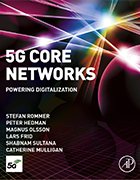What IT pros can expect from 5G core network architecture
5G is the first 'G' in the cloud, which means its network architecture can enable functions, services and capabilities past cellular generations couldn't. Here's what to expect.
With 5G, cellular core network architecture will fundamentally shift, as will its functions and services.
5G core network architecture -- the central network element that provides services to connected users -- will be a more flexible, service-based architecture than those of its predecessors. This architecture enables operators to place 5G core networks and functions in cloud environments, according to author Cathy Mulligan, and enable 5G to be the first cellular generation in the cloud.
The book 5G Core Networks by Mulligan, Stefan Rommer, Peter Hedman, Magnus Olsson, Lars Frid and Shabnam Sultana explored the fundamentals and key features of 5G core networks.
Below is an excerpt from the book: Chapter 13, "Networks functions and services." This chapter describes 5G core network functions based on the 3rd Generation Partnership Project's (3GPP) 5G architecture. It also explores 3GPP's service-based architecture in relation to 5G.
Before readers explore the chapter, they should understand what a network function is, as well as the basics of cloud architectures and service-based interfaces, Mulligan said. The chapter describes how to create service-based interfaces in a service-based architecture and how operators have structured their "microservice-esque" architectures, as Mulligan said they offer features like microservices but they aren't exactly the same.
 Cathy Mulligan
Cathy Mulligan
However, as-a-service, on-demand delivery from mobile networks through microservices is a major change and is where Mulligan sees interesting new advances with 5G core network architecture. Advancements include bandwidth and latency improvements, among others.
From an IT perspective, Mulligan said it will be important to understand how to integrate on-demand capabilities from 5G networks around policy, quality of service, edge computing management and potentially network slicing, if operators enable access to network slices. This can benefit IT teams, as they could integrate these capabilities into other cloud platforms and architectures.
Overall, IT professionals can expect 5G core architecture to differ greatly from the core network of past cellular generations, as well as the introduction of many more cloud-based capabilities.
Explore 5G Core Networks
Click here to explore Chapter 13, "Network functions and services."






